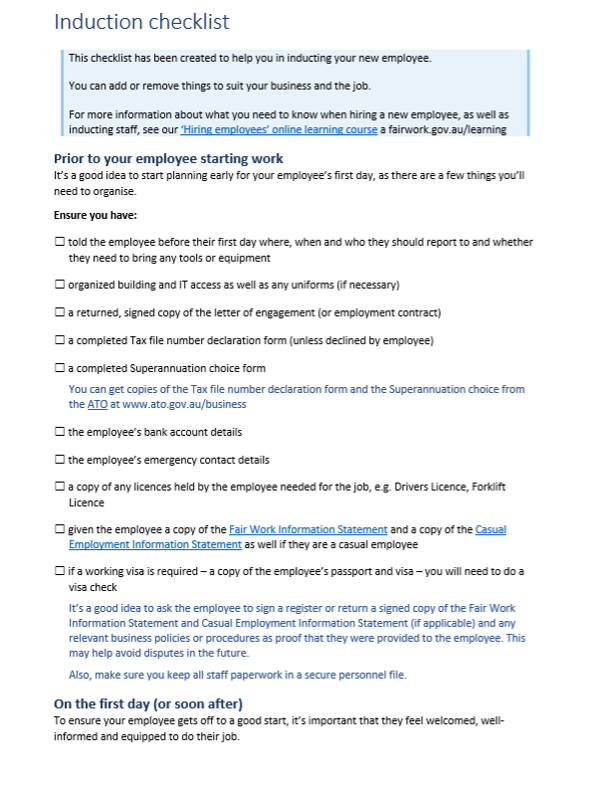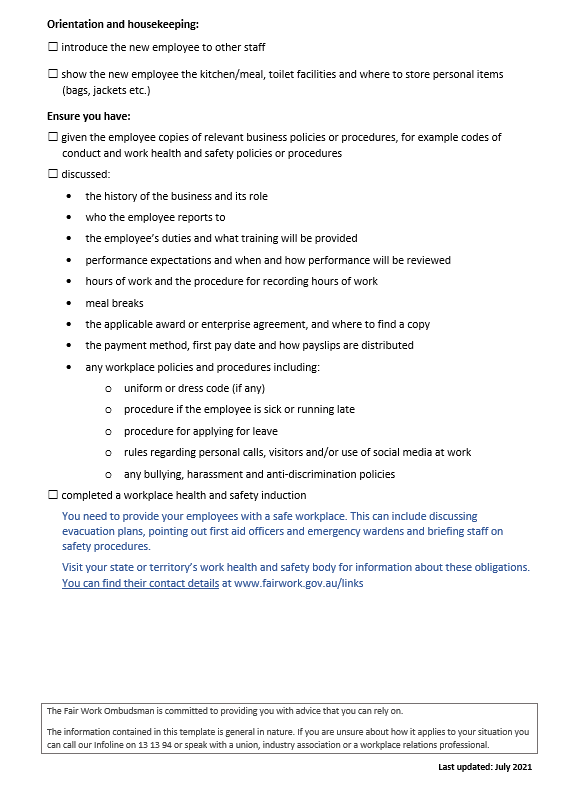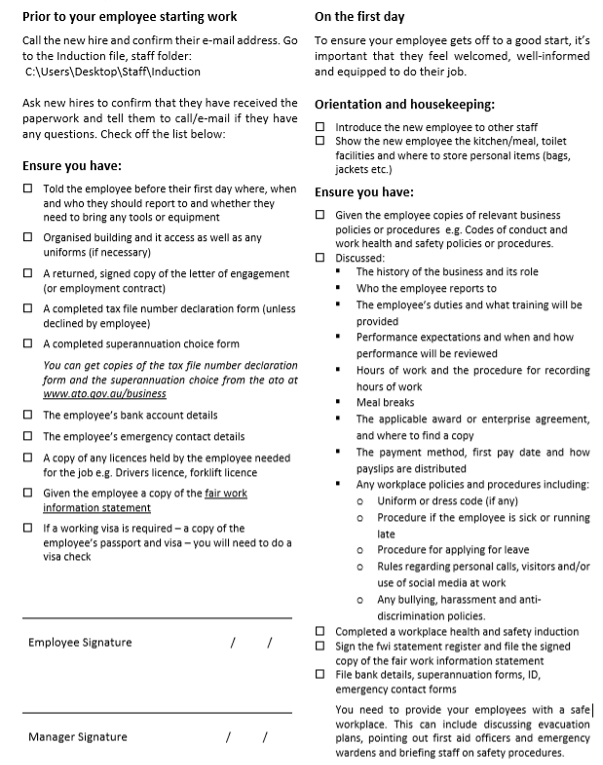In this section you will learn how to:
- Check that induction processes are followed across the organisation
- Provide access to training and ongoing support for all persons engaged in staff induction
- Obtain feedback from participants and relevant managers on the extent to which the induction process is meeting its objectives
- Oversee the management of probationary employees and provide them with feedback until their employment is confirmed or terminated
- Make refinements to induction policies and procedures
Supplementary materials relevant to this section:
- Reading H: A Handbook of Human Resource Management Practice 3
- Reading I: Letters of Successful and Unsuccessful Probation Period Templates
Managing staff induction is critical to ensure that the employee is settled and to address any possible issues that may have arisen. Having effective induction processes in place will be important to ensure that your new hire/s will have a comprehensive understanding of what is expected to them from day dot. Not having effective induction processes will negatively impact your company. Example costs and factors include but are not limited to:
- Recruitment costs of replacement
- Induction costs (training etc.)
- Cost of temporary agency replacement
- Cost of extra supervision and error correction
- Gap between the employees’ value to the company and the cost of the employees’ pay and benefits
This final section of the module will teach you how to manage induction within an organisation by monitoring induction processes, provide training to relevant staff, overseeing the management of employee probationary periods, obtaining feedback and making applicable refinements to existing policies and procedures.
Read
Reading H – A Handbook of Human Resource Management Practice 3
Reading H supplies some additional information regarding Induction.
In the next video, watch how a company explains the benefits of a good induction.

Before you can monitor an induction process, your organisation needs to have one in place. Especially in smaller organisations, it is not uncommon for the induction process to be very informal and unstructured. While this may work for some companies, for most organisations it will be very difficult to monitor such processes and even harder to ensure that everyone in the organisation follows the same format. Below is a a basic overview of what should be covered during a typical induction:
New staff members
New staff members will need a more comprehensive induction than existing ones. Inductions help new staff understand the culture of your business and the processes they need to follow.
The first day induction
The first day for a new staff member at your business is particularly important. You will want to make the new staff member feel welcome and enthusiastic about their new job.
- On a new staff member's first day, you should:
- Introduce them to their colleagues, managers and supervisors
- Take them on a tour of your business premises, pointing out important areas such as:
- Toilets
- Fire escapes
- Break rooms
- Their work area.
- Provide them with general information on your business, which may include:
- A copy of your business's code of conduct
- Annual reports
- Your business plan
- Marketing materials
- Organisational charts
- Phone lists.
- Record essential details, including their:
- Superannuation account
- Bank account
- Tax file number
- Emergency contacts.
- Explain employment conditions and policies, including:
- Work hours and breaks times
- Smoking
- Pay details, including when they can expect to be paid
- Leave entitlements
- Probation periods for new staff.
- Provide any necessary work health and safety information, including:
- Fire and evacuation instructions
- Details about any training you've planned for them.
- Explain their duties and have some work for them to do
- Provide necessary equipment, uniforms, email addresses and computer access details
- Ask if they have any questions.
(Adapted from Queensland Government, 2022)
Once you have induction processes in place, the next step will be to train relevant staff on conducting inductions. Depending on your organisation, the induction process may be conducted by crew trainers, team leaders, line managers, department managers, assistant managers, store managers or human resource managers. Similarly to training staff on recruitment and selection processes, induction is best trained on-the-job. It is a good idea to have a run through sheet created for those conducting inductions so they can follow the plan throughout the induction. A sample checklist is provided below:


(Fair Work Australia, 2021)
As you can see from the checklist , there is a lot of information to cover during an induction! For this reason, it is very important to provide your staff with tools they can use to ensure they are covering everything. The checklist can be altered to include specifics pertaining to your organisation. An induction checklist will be a great tool for you to use while training staff but also for monitoring the induction process.
An induction checklist will be a great tool for you to use while training staff but also for monitoring the induction process.
Having those who conduct inductions complete a checklist for each new hire will also allow for a record to be kept as to what training was provided and any areas that might have been missed. It is a good idea to have a policy in place that stipulates that this is mandatory for each new hire, and the procedure you would create would be to complete the checklist.
For monitoring induction processes, you should first observe how inductions are currently being conducted. You may find that in some organisations, certain departments will be conducting inductions according to organisational policies whereas others will tend to perform more of an unstructured format. It is important to check that induction processes are consistent across the organisation. This is not only for the benefit of the new hires, but also to keep the organisation legally protected. To establish the processes you can follow the below steps:
- Create, update or implement and induction policy and procedure
- Obtain support from senior management
- Trial the new induction policy/procedure on a smaller group
- Make any necessary amendments
- Communicate policy and procedures with all staff involved (face-to-face is more effective)
- Follow up through observation and random checks
- Provide additional training and support for induction delivery
- Review completed checklists on a monthly basis and action any discrepancies you find
If your organisation already has effective induction policies and procedures, you would only need to start from step 5 of the process for you to effectively monitor inductions. Through having a mix of face-to-face communication, providing training, and providing written documents, you will be able to create an effective system for monitoring inductions in your organisation. You may find that perhaps one staff member in particular is not completing inductions correctly – if that is the case they may need additional training. Or you may find that particular parts of the induction keep getting missed – is this a time issue? A relevancy issue? A training issue? You will need to assess any potential issues and make necessary amendments to remedy them. Furthermore, it is important that the checklist doesn’t serve as a “tick and flick” process, so it is a good idea to check that they are being completed thoroughly and honestly. A good way to do this is to obtain feedback from new hires and other relevant staff.
Obtain Feedback
Unless you have eyes and ears everywhere, it is impossible for you to personally have enough information to assess whether your current induction processes are effective. Of course indicators such as employee performance, productivity, turnover rates, and the amount of staff who go beyond their probationary period are clear indicators, it is better to seek feedback before these types of outcomes occur.
When gaining feedback regarding inductions it is advisable for you to consult with both participants and those who conduct the inductions. The reason for this is so that you gain different perspectives about the processes. Staff conducting inductions may perceive that there are no issues and that everything is going well. Until you look at how the participants are perceiving the induction training you will not have complete information.
There are various ways you can monitor your induction processes and ways you can gain feedback, from evaluation sheets or one on one interviews, employee engagement surveys, assessing common queries, monitoring retention rates for new employees, and assessing information provided through exit interviews.
One of the best methods of gaining feedback from staff completing inductions is to ask them. It can be beneficial to have an informal discussion to ask for their opinions and views on what is working and what isn’t working. Once you have collated the feedback, you will be better informed to make any necessary adjustments. It is important to gain feedback during the process rather than waiting until the completion of an employees’ probation. This is because the feedback you receive may result in you taking the necessary action prior to the employee leaving or being terminated. To do this, you will need to ensure that you are overseeing the management of probationary employees until their employment is confirmed.
Reflect
Think about a time when you were a new hire in the organisation. Can you recall what systems the organisation had in place to monitor your progress and performance?

“A probationary period is usually for the first 3 months of a new job, depending on the role. It's designed to give both you and the new employee the chance to discuss if they're suited to the role.”
(Business Victoria, 2022)
Depending on your organisation and the employment contract, an employees’ probationary period may range between three months to twelve months. During this time you should ensure your organisation has systems in place that allow regular review of the employees’ performance and cultural fit. It is bad practice to terminate an employee without giving them the opportunity to improve and you could also find yourself in unfair dismissal cases if it is not handled properly.
There is no such thing as a bad employee, it is simply a case of one that fits and one that doesn'tLueger and Korn 2006
There is no such thing as a bad employee, it is simply a case of one that fits and one that doesn’t (Lueger and Korn 2006). No new employee will start a position with the intention to perform poorly. In most cases, poor performance is a result of ineffective recruitment, selection, induction, and management processes. The whole point of a probationary period is to give both employees’ and employers a time frame to assess whether the new hire is suitable for that particular role and the organisation. Therefore, you should ensure that there is a system in place to allow for regular review throughout an employees’ probation.
Not all reviews need to be of a formal nature. For example, the policy you introduce may require an employee’s direct supervisor to have an informal discussion weekly, a sit down discussion monthly, and then a formal final discussion prior to the probationary period ending. The employee should know how they are performing throughout their probationary period and receive regular feedback. It is important to have these performance conversations to help the employee understand what is required of them and whether or not they are meeting or failing to meet expectations.
If employees are not lasting through the probationary period, you will need to start the entire recruitment, selection, and induction process again to fill the vacant position. It is a better use of resources to give a new hire a chance to improve. Unfortunately, despite re-training and regular performance reviews, not all employees will make it through. Some will need to be terminated, and that is just a part of business. It is important that you have policies and procedures in place for keeping records of employee performance discussions throughout the probationary period and also when they have confirmed employment.
If the decision to terminate during probation is made, you are required by law to provide written notice to an employee during the probationary period (Fair Work Ombudsman 2015). Conversely, if an employee is successful through their probationary period if is still important to provide them with written confirmation (a sample letter for this situation is also provided in Reading J).
If you have detailed policies and procedures in place, it will help you oversee how probationary employees are managed within your organisation. Unless there are systems in place, it will be quite difficult to ensure each new hire is given ample opportunity to improve performance and also to terminate an employee’s employment lawfully if they fail to make these improvements.
Read
Reading I – Letters of Successful and Unsuccessful Probation Period Templates
Two letter samples, for a Successful and Unsuccessful probation period, have been provided in Reading I.
Reflect
Imagine you started a new job and your probationary period is 6 months. During these 6 months you have received little to no feedback. One week prior to your probation period ending, you receive a letter of employment termination. How would you feel?

Once you have trained staff to conduct inductions, have monitored the induction process, gained feedback from participants and staff, and have assessed employees’ probationary periods, the final stage will be to make any necessary amendments. Not every policy, procedure, and process you implement will be perfect. You need to be able to make the decision to make changes when something isn’t working.
For example, perhaps you have introduced a new induction policy after analysing performance and obtaining feedback that indicated that new hires were not being told all of the information they need to know. The staff in charge of induction are following the new mandatory processes and checklists, but new hires are still not recalling the vital information. So what is going wrong? There could be many possible reasons that this issue is occurring, including but not limited to:
- Too much information provided on the first day
- Too much unnecessary detail provided
- Not enough time allocated and trainers are rushing over critical points
- The induction checklist is not relevant
- The induction trainer is not good at explaining information thoroughly
You will need to make decisions based on the information you have at hand in order to eliminate or reduce the impact of such issues. Potential solutions and amendments you could make to refine induction policies and procedures could include but are not limited to:
- Stagger induction information over three days
- Remove unnecessary detail out of the induction and place in a separate document that can be read at the new hires’ own convenience
- Increase induction time
- Update induction policies and procedures to ensure relevancy
- Re-train staff conducting inductions on better communication practices
While you may find the above amendments useful, it is impossible to provide you with solutions that will remedy every issue – your business is unique and so are the issues. It is always a good idea to gain a second opinion from your supervisor or senior management prior to making any amendments. The value in a second opinion is that the person you discuss the issues with may be able to see the most appropriate solution.
With the business environment rapidly changing, you need to be aware that policies and procedures created ten years ago probably don’t apply today. As demonstrated earlier in the module, unless policies and procedures are relevant and have senior management support, you have little to no chance in getting others within the organisation to follow them. As with any new or updated policy, any amendments made will need to be communicated to relevant staff and management.
To further heighten your understanding of managing the staff induction process, we will continue with the “Northside Allied Health” case study. The final part of the case study will look at how Abi manages the induction process for her new staff members.
Case Study
After the new applicants had confirmed their offers of employment, Abi needed to decide how she was going to conduct their induction training. Inducting all the new employees at once was not practical based upon her resources, so she decided to schedule four inductions staggered over the course of a week.
The new policy she introduced earlier in the year stated that important documents such as the employee handbook, tax declaration form, emergency contact form, superannuation form and a copy of the Fair Work Information statement should be issued to new hires prior to their first day. This way, new hires were not overloaded with information on their first day and it sped up the induction process by having these documents signed and ready to go. She set up individual files for each employee with a mark for each document required to keep everything organised. (A copy of the checklist they used is below this case study).
To monitor the effectiveness of the induction training, Abi had an informal discussion with each of the new hires and asked them to recall what they had learned, whether they were struggling with anything, if they understood everything and how they felt overall within the organisation and their new role. She also wanted some documented feedback, so she asked the new hires to complete an anonymous evaluation survey through the company’s staff training portal.
Once all inductions were completed, Abi given the importance of monitoring new hires throughout their probationary period, scheduled in informal chats with each new hire on a fortnightly basis and a formal discussion at the midpoint of their probation into their work calendars.
One of the new hires was struggling with the role and after plenty of guidance and additional training, it was a mutual decision between the staff member and the new hire that she was not suitable for a reception role. Due to legal compliance, Abi issued her with a formal termination letter. The remaining new hires were excelling in their roles and at the end of their probation they received a confirmation of employment.
After the Christmas period was finished, Abi sat down with the owner, Boris, and asked for his thoughts on the entire process (having kept him up to date throughout). He suggested that they should gain feedback regarding an employee’s induction at the end of the process rather than in the first few weeks. His reasoning was that most employees would be less inclined to point out faults in training while they were in probation. He suggested that there should be an anonymous survey open to those after they have received confirmation of employment. Abi was stunned, it was such a great idea. She incorporated his suggestion and revised the induction policies and procedures.
Induction Checklist

In this section you learned ways that you can monitor the induction processes across an organisation through checklists, reviews, discussion, and meetings. Next you learned the importance of, and how to provide, access to training and ongoing support for all persons engaged in staff induction. From there you learned various ways you can evaluate induction processes and oversee the management of probationary employees. Finally, you learned how to identify potential issues with induction processes and how to make necessary refinements.
- Better Up. (2023). [Photograph of a group of people smiling and shaking hands.] https://www.betterup.com/blog/email-before-first-day-of-work
- Business Victoria. (2022). Staff induction and probationary review. http://www.business.vic.gov.au/hiring-and-managing-staff/staff-recruitment/new-staff-induction-program-and-probation-period
- Eazy Training. (n.d.). 7 Key Success Factors for an Induction Training Program. http://eazytraining.com/resources/7-key-success-factors-for-an-induction-training-program/
- Fair Work Ombudsman. (2021). Induction Checklist. https://www.fairwork.gov.au/sites/default/files/migration/715/Template-induction-checklist.docx
- Queensland Government. (2022). Staff onboarding and inductions. https://www.business.qld.gov.au/running-business/employing/training/staff-onboarding-inductions
- Unidus Community Centre. (2022). [Photo of two people shaking hands]. https://www.unidus.org.au/benefits-of-face-to-face-meetings/
